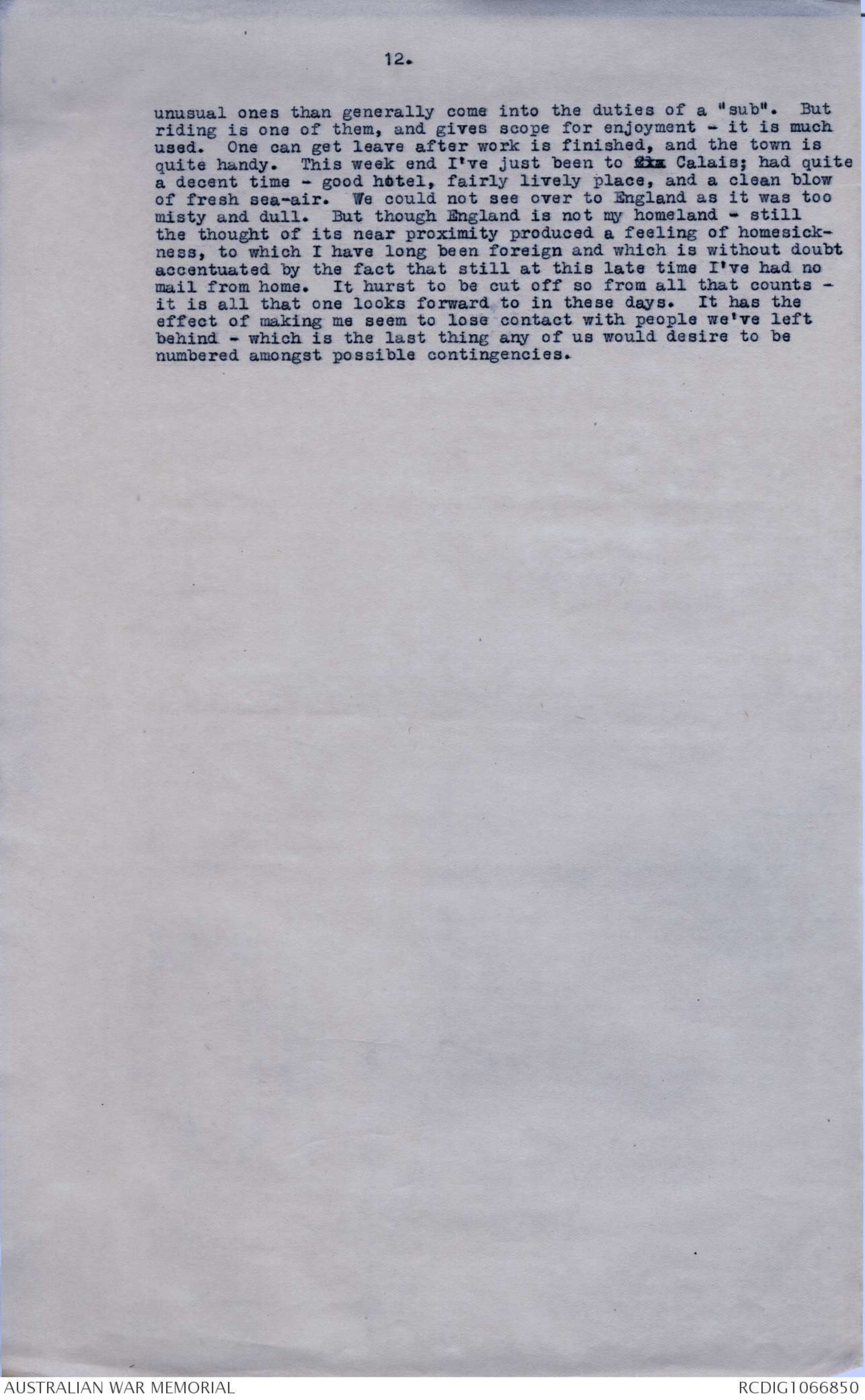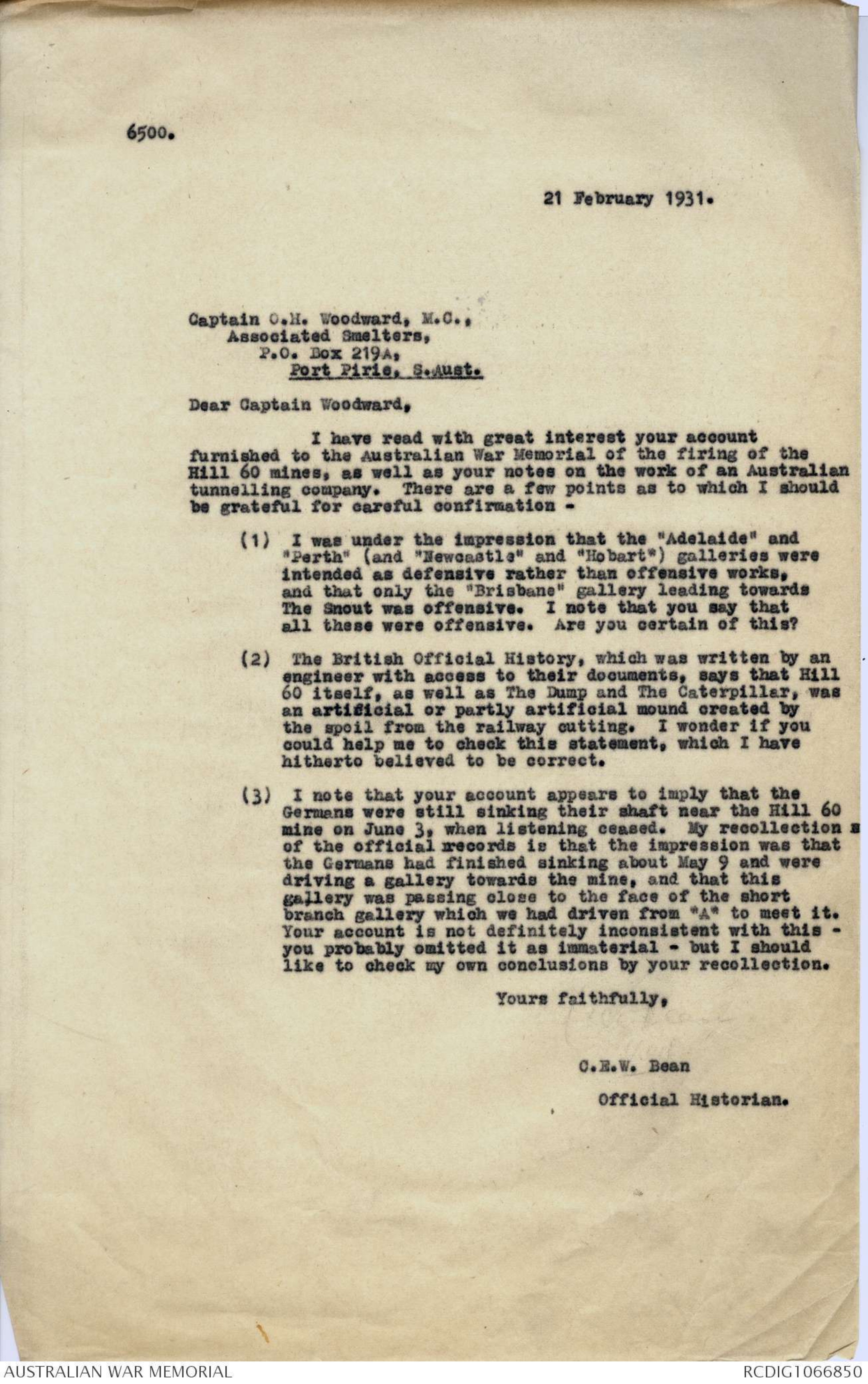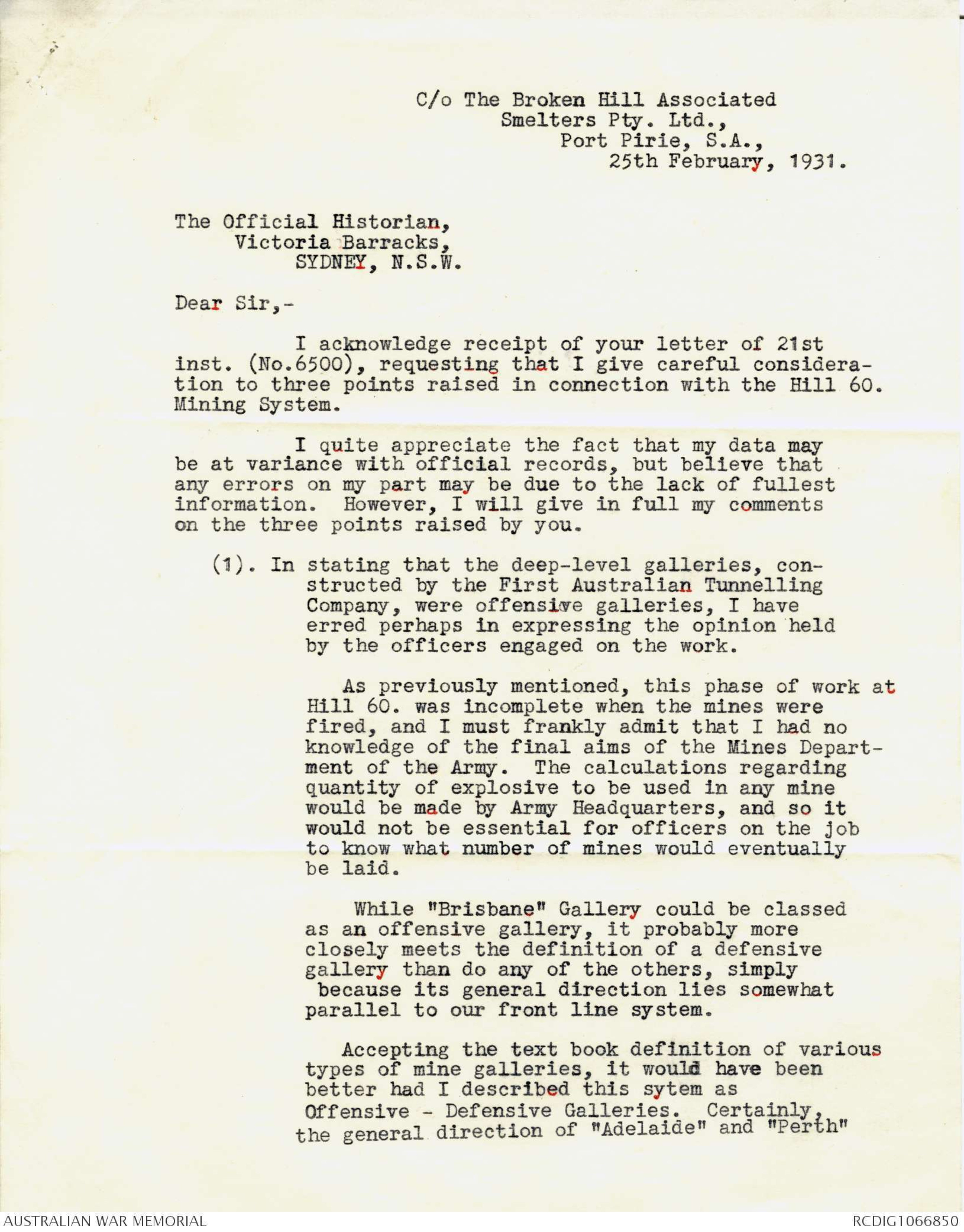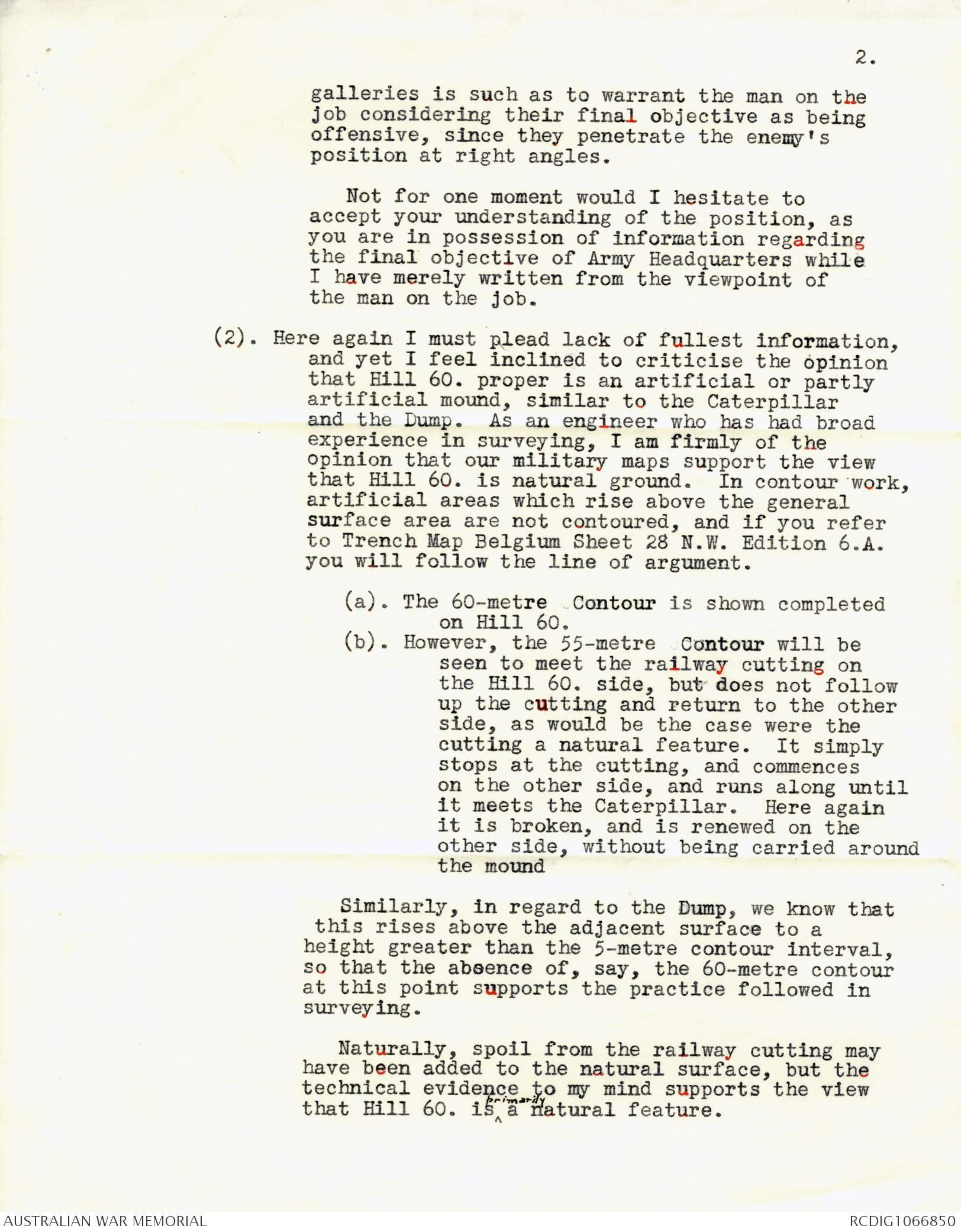Charles E W Bean, Diaries, AWM38 3DRL 606/248/1 - 1917 - 1931 - Part 16










9.
All day long great sprays and jets of black smoke, earth, and
fragments of trench go hurtling up from the enemy's lines.
This will be one of the biggest battles in the world's history.
I met Dimmock of Nanango yesterday - he is in the 41st.
Saturday, 2/6/17.
Much bombardment as usual, of which we caught some also as
uaual. All sorts of artillery stunts, to which the foe replies
hardly at all. I did not get up till afternoon, so can't say so
for the morning. Our planes are greatly in evidence - in direct
contrast to his.
Sunday, 3/6/17.
We were relieved last night and got out fairly well to time.
We are billeted this time in a new place. The people have just come
out of church - they certainly go there in large numbers. I've
noticed that wherever we have been in France. A magnificent day - x
but I've had no breakfast, the hour being 11.30 a.m. My lukj was
luck was right out, and at 7 p.m. I set out with a party of 25 to
do front line work. We had an exciting time! At the corner we ran
into a strafe which dispersed our party and we did not reunite till
three hours after. Those whom I did gather worked till a little
after midnight, and then we set out home. We smelt a little gas -
lachrymatory - and for a while I held the party up. When we did
get a move on we walked into the worst mess I've been in. He poured
over gas shells in hundreds; we could hardly see our way - four
ammunition dumps blew up, several times we were some of us blown
down by explosions, and then he poured over his H.E. I thought
we'd never get through. At one stage I put the men in shell-holes
till that particular strafe amongst the whole had abated. I was
very sick - we all were - coughing, and staggering, with our eyes
streaming tears from the lachy gas. It was a hell of a time. We
pushed on, however, and gas was thick all along the four miles of
our road. I inhaled a fair amount, as I had to control and guide
the men, who often became just a little panic stricken. We passed
eight casualties on the road. At 2x 2.20 I finally landed my party
in the town, and went round banging up everyone. One woman xxxed
died in this town. The doctor sent me off to bed and sent eleven
of my men to hospital.
Monday, 4/6/17.
Am in bed at time of writing, 4 p.m. Except for sore throat,
stringency in breathing and headache, I am all right. Haven't heard
of my fellows yet - they are some way off. Have orders to stay here
in bed till allowed up - I can at least get a much needed rest.
But the Hun shelled the town about midnight, killing four people.
All the inhabitants were wildly excited - screamed and shouted and
ran to their cellar. The people here tried to get me out but I
wasn't having any, and stayed in bed quite comfortably.
Tuesday, 5/6/17.
Stayed in bed and read till 4 p.m. xxx Have only an irritation
in my throat and slight tightness in the chest. However, as the
M.O. told me to stay here and keep absolutely quiet, I suppose it
must be done. Wellings, B'ge gas officer, was caught by delayed
action gas three days after the attack, and there is no hope for him,
they say. Great row, chiefly heavy guns, back where we are at presen
present.
Wednesday, 6/6/17.
Have had a very strenuous day. After a night spent in sleeplessness
- due to bombardment - I slept in till about 11 a.m. Then
a shell came shrieking over and landed some 30 yards away, knocking
16 men of No. 8 platoon. Pandemonium broke loose. Shells rained
10.
upon the town - the civilians shrieked and ran all over the place.
The groans of the wounded, the crash of falling masonry, and tinkle
of glass from hundreds of windows - and the wailings of the poor
little children, some of whom were hit - all combined to make one
realise how hideous war can be. He made a mess of the place, and
generally upset things for a while. However, things all got
straightened as usual, and we resumed our work. This takes my
narrative up to 3x 3.10 a.m. on the morning of -
Thursday, 7th June 1917.
Since then we began our great offensive. The battalion came up
through gas and a bombardment, and got safely housed in our locality
about an hour before the push. At a certain hour the guns roared out
in a tumult of sound, the starting time of which was given by explosion
of two mines. Their concussion shook the earth for miles around.
Certain of our troops then went over to take with very little effort
the line set as a task to them. The foe's lines did not exist -
there was nothing but a tumbled jumble of heaved-up brown earth for
hundreds and hundreds of yards. Nothing could have existed in that
hell. No wire was left - and before the bombardment it had been a
model of defensive wiring. We waited in anxiety - we, that is, who
were in reserve, to hear the result, and great was our relief to hear
of the attainment of all objectives by our troops. Then the first
batch of prisoners came in - amid much curious eyeing by our assembled
soldiery. The prisoners did not by any means impress one by reason
of physique or bearing - and they all seemed much frightened and
shaken. We are in reserve and during the night were rushed securer
dugouts in case of extensive shelling. There we are yet and are
carrying to the troops in the front line. We twice came through
hellish barrages put up by the foe in his attempt to counter-attack -
it was a case of setting one's teeth and trusting to Providence to
bring one safely through the perilous passage from shell-hole to
shell-hole. But all was shellhole - lip on lip - up and down, up and
down, all the time. We got back safely, however, but our company is
not of too great a size by reason of our misfortunes. At the moment
of writing, our guns are pouring in a hurricane of drum-fire, so that
one cannot hear one's neighbour even at a distance of a few feet.
I shall not attempt to keep strict chronological accuracy till such
time as more peaceful surroundings lend themselves to that end,
12th June 1917.
Since last writing I have had a terrible time. At 1 p.m. we
moved up to our positiion whence the foe had been expelled some few
hours previously. There was no line, just the position given on the
map, and there we set to and dug in for our lives. I held the front
line of our company front, and spurred the men on to "get down".
Fortunately the Hun did not manifest much activity, though he was
clearly visible some 700 yards away. But after a few hours down came
his barrage, and we sat tight in our miserable little ditches - no
trenches of course. There were many of the enemy dead about - thick
just ahead of my position. All day long the shells roared - the plai
plain was a mass of dust and smoke. And at night the bombardment grew
in intensity, the foe using heavy guns on our position, and casualties
began to be numerous. We had already repulsed several counterattacks
and with unceasing watch awaited what might befall. Twenty-four
hours passed, and then we experienced a terrible time. We -
our brigade, that is - made a further advance, and the enemy poured
in a dreadful fire on us who were just behind the advancing lines.
One platoon was wiped out - men blown to pieces, terrible to view,
others buried and shell-shocked. To right and left shell after shell,
coming over incessantly in streams, poured upon our fragile lines,
bringing death and wounds to great numbers. Men were blown up and
killed all along - it is impossible to describe the scene. Morning
broke to find us only 60% strength - poor Bartley, Fisher, R.D., and
Harris were killed (we found out later that Fisher, R.D., was not
killed, but severely wounded), leaving Tom, Jack, and myself the
only officers remaining of "A” and "C" coys. Many were missing,
11.
probably buried. We never saw them again.
The stretcher-bearers were magnificent, doing great work, all
the while. The company was reduced to 58 men! Next day we, the
remainder, sat in our positions while the guns went all day long.
The stench from the dead was dreadful - many were pi in pieces and
could not be identified - while the dead and unburied enemy in
front of us added to the nauseous horror. We were all much shaken
and gladly, very gladly, were relieved after 72 hours of hell. We
were chased back by the fire of heavy guns, even while relieving.
We are now out of the game for a bit while we reorganise. What has
been doing in the rest of the line we know not, though we hear
rumours of great deeds - sufficient for us was the hell we ourselves
endured.
14/6/17
We have come out for a very welcome rest, to refit, reorganise,
and retrain our depleted units. The advance seems to have slowed dow
down. Today I saw papers for the first time and learnt of the
doings of other divisions. Well we took a good part in the Battle
of Messines - our batt. came in for special praise from the Brig. on
account of its fine work in the position a position that held no
promise of compensating glory of action and mobile achievement.
We are now out of the xxxxx sound of guns - but many of us are yet
sick from gas and "dennerite" fumes - it brings on a condition akin
to bronchitis, most annoying.
17/6/17.
Just the common round of training has been the order of the
day. But it has been most surprisingly warm - quite equal to
weather at home for heat. We continue to hear good news from our
battle front. Tich Graham was taken away - he got a sunstroke.
That means I've lost three sergeants in five days! Have had no
mail yet - that makes it three weeks now since last I heard.
27/6/17.
Since last writing I haven't felt at all disposed to writing.
A week ago I was suddenly warned to attend a school at Wisques - a
long way behind the line. As I was feeling rather run down I much
appreciated the chance of a rest indeed. A short quick train
journey got me to my destination. I am to be here for five weeks.
The country is just delightful - untouched by the ravages of war -
clear crisp air - high situation - regular hours, riding, and sports
will, I think, all comprise combine to make me and all of us fit
again. I met Percy Toft, my old schoolmate at Bundaberg, and
exchanged many a yarn. He had heard I was dead - that's twice I
have been supposed "out". But not for me. No mail has come yet
at all - rather "off". We have all also one peculiar trait - we
are always asleep and drowsy. This I think is due to the high
altitude in which we dwell. We overlook the city of St. Omer, some
three miles off, and can oversee some thirty miles of plain and
rising ground - with the famous hills of Cassel and Mont de Cat
prominent in the scene.
8/7/17.
Obviously am getting lax in literary (?) observances. But time
gets along as usual overquick when once routine, such as one meets
in a school, asserts its sway thereon. And since one day succeeds
another with but little change save in subjects under study, there
remains but little to chronicle that calls for comment or for the
possibility of being recorded, to serve in future years to recall
impressions of a foreign soil and a strange and strenuous time.
The routine ordinarily encountered varies little, and concerns
itself chiefly with tactics (not minor) and higher branches and more
12.
unusual ones than generally come into the duties of a "sub". But
riding is one of them, and gives scope for enjoyment - it is much
used. One can get leave after work is finished, and the town is
quite handy. This week end I've just been to Cla Calais; had quite
a decent time - good hotel, fairly lively place, and a clean blow
of fresh sea-air. We could not see over to England as it was too
misty and dull. But though England is not my homeland - still
the thought of its near proximity produced a feeling of homesickness,
to which I have long been foreign and which is without doubt
accentuated by the fact that still at this late time I've had no
mail from home. It hurst to be cut off so from all that counts -
it is all that one looks forward to in these days. It has the
effect of making me seem to lose contact with people we've left
behind - which is the last thing any of us would desire to be
numbered amongst possible contingencies.
6500.
21 February 1931.
Captain O.H. Woodward, M.C.,
Associated Smelters,
P.O. Box 219A.
Port Pirie, S.Aust.
Dear Captain Woodward,
I have read with great interest your account
furnished to the Australian War Memorial of the firing of the
Hill 60 mines, as well as your notes on the work of an Australian
tunnelling company. There are a few points as to which I should
be grateful for careful confirmation -
(1) I was under the impression that the "Adelaide" and
"Perth" (and "Newcastle" and "Hobart") galleries were
intended as defensive rather than offensive works,
and that only the 'Brisbane" gallery leading towards
The Snout was offensive. I note that you say that
all these were offensive. Are you certain of this?
(2)The British Official History, which was written by an
engineer with access to their documents, says that Hill
60 itself, as well as The Dump and The Caterpillar, was
an artificial or partly artificial mound created by
the spoil from the railway cutting. I wonder if you
could help me to check this statement, which I have
hitherto believed to be correct.
(3)I note that your account appears to imply that the
Germans were still sinking their shaft near the Hill 60
mine on June 3. when listening ceased. My recollection x
of the official records is that the impression was that
the Germans had finished sinking about May 9 and were
driving a gallery towards the mine, and that this
gallery was passing close to the face of the short
branch gallery which we had driven from "A" to meet it.
Your account is not definitely inconsistent with this -
you probably omitted it as immaterial - but I should
like to check my own conclusions by your recollection.
Yours faithfully,
C.E.W. Bean
Official Historian.
C/o The Broken Hill Associated
Smelters Pty. Ltd.
Port Pirie, S.A.,
25th February, 1931.
The Official Historian,
Victoria Barracks
SYDNEY, N.S.W.
Dear Sir, -
I acknowledge receipt of your letter of 21st
inst. (No.6500), requesting that I give careful consideration
to three points raised in connection with the Hill 60.
Mining System.
I quite appreciate the fact that my data may
be at variance with official records, but believe that
any errors on my part may be due to the lack of fullest
information. However, I will give in full my comments
on the three points raised by you.
(1). In stating that the deep-level galleries, constructed
by the First Australian Tunnelling
Company, were offensive galleries, I have
erred perhaps in expressing the opinion held
by the officers engaged on the work.
As previously mentioned, this phase of work at
Hill 60. was incomplete when the mines were
fired, and I must frankly admit that I had no
knowledge of the final aims of the Mines Department
of the Army. The calculations regarding
quantity of explosive to be used in any mine
would be made by Army Headquarters, and so it
would not be essential for officers on the job
to know what number of mines would eventually
be laid.
While "Brisbane" Gallery could be classed
as an offensive gallery, it probably more
closely meets the definition of a defensive
gallery than do any of the others, simply
because its general direction lies somewhat
parallel to our front line system.
Accepting the text book definition of various
types of mine galleries, it would have been
better had I described this sytem as
Offensive - Defensive Galleries. Certainly
the general direction of "Adelaide" and "Perth"
2.
galleries is such as to warrant the man on the
job considering their final objective as being
offensive, since they penetrate the enemy's
position at right angles.
Not for one moment would I hesitate to
accept your understanding of the position, as
you are in possession of information regarding
the final objective of Army Headquarters while
I have merely written from the viewpoint of
the man on the job.
(2). Here again I must plead lack of fullest information,
and yet I feel inclined to criticise the opinion
that Hill 60. proper is an artificial or partly
artificial mound, similar to the Caterpillar
and the Dump. As an engineer who has had broad
experience in surveying, I am firmly of the
opinion that our military maps support the view
that Hill 60. is natural ground. In contour work,
artificial areas which rise above the general
surface area are not contoured, and if you refer
to Trench Map Belgium Sheet 28 N.W. Edition 6.A.
you will follow the line of argument.
(a). The 60-metre "Contour is shown completed
on Hill 60.
(b). However, the 55-metre Contour will be
seen to meet the railway cutting
on the Hill 60. side, but does not follow
up the cutting and return to the other
side, as would be the case were the
cutting a natural feature. It simply
stops at the cutting, and commences
on the other side, and runs along until
it meets the Caterpillar. Here again
it is broken, and is renewed on the
other side, without being carried around
the mound
Similarly, in regard to the Dump, we know that
this rises above the adjacent surface to a
height greater than the 5-metre contour interval,
so that the absence of, say, the 60-metre contour
at this point supports the practice followed in
surveying.
Naturally, spoil from the railway cutting may
have been added to the natural surface, but the
technical evidence to my mind supports the view
that Hill 60 is, ^primarily a natural feature.
3.
(3). This question is one difficult of solution, and any
view expressed is dependent upon the correctness
or otherwise of the actual listeners' conclusions.
However, I have no knowledge of the fact that
9th May is officially recorded as the date on
which the Germans ceased sinking, and thereafter
began to drive a gallery.
All officers carried out listening in this
area, and I believe the opinion of the majority
was that the enemy was still operating above the
level of "A". Gallery. In support of this, I
offer the following information:-
I was the officer in charge of the laying
and the firing of the mine which, on 19th December,
wrecked the enemy's shaft. My estimate
at the time was that the enemy's workings were
considerably less than 10 ft. above our level,
probably nearer 5 ft. to 6 ft.; now, the mine
when fired disturbed little of our area, the
resultant shock being solely responsible for
the breakage of the set of leads to Hill 60.
Mine. The fact that the gases from the explosion
rushed up the enemy shaft and ignited at the
surface leads one to the belief that a minimum
of disturbance of ground away from the shaft
would follow.
Consequently, the enemy had this knowledge;
i.e., at a known depth of shaft, a counter-mine
was fired from a position at greater depth than
his shaft bottom.
The enemy selected a new site for a shaft,
and, on the assumption that he rightly interpreted
the position arising on 19th December, is it
logical to assume that on his next venture he
would sink a shaft to a greater depth than was
previously the case? This assumes, and I think
rightly, that the enemy was seeking to take the
offensive.
Assume that the enemy completed sinking his
shaft on 9th May, he would have been driving a
gallery for about 3 weeks, and giving a rate of
progress only 50% of what we attained in driving
the face of his gallery should have been so
removed from our listening post as to make it
difficult to pick up the sounds. On the other
hand, shaft sinking is a relatively slow progress.
4.
Of course, it may be that the actual work of
shaft-sinking had just previously ceased, and
work connected with the opening-out of a
gallery from the shaft was in progress.
However, I am of the opinion that the enemy's
workings were in approximately the same vertical
plane as when sounds were first clearly picked
up.
I trust that these explanations may be of
to assistance to you, and, while such views governed the
writing of a personal story of the Firing of the Mines,
how important it is that you, as Official
Historian, must keep to recorded fact, rather than to
individual theories.
Yours truly,
OH Woodward
6516
3 March 1931.
Captain O.H. Woodward, M.C.
c/o The Broken Hill Associated Smelters Pty. Ltd.,
Box 219A,
Port Pirie, S.Aust.
Dear Captain Woodward,
I have to thank you for your letter. I, too,
much doubt whether Hill 60 proper is really a spoil bank,
although it may have been somewhat raised by the deposition
of the soil near the cutting.
Yours sincerely,
C.E.W. Bean.
 Sam scott
Sam scottThis transcription item is now locked to you for editing. To release the lock either Save your changes or Cancel.
This lock will be automatically released after 60 minutes of inactivity.